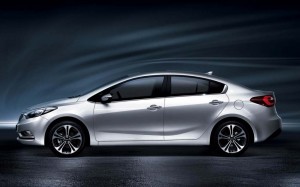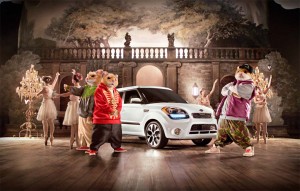The once very unhip Kia brand has undergone a massive makeover in recent years, thanks to a trio of hip-hop “hamstars,” a rock star of a design chief – and a blitz of new products.
The new model assault is set to continue, Kia officials reveal, at the upcoming Los Angeles and Detroit auto shows. And to feed the growing demand for those and existing products like the Optima and Soul, Kia management is now studying the option of expanding its North American production base – a move that might include the addition of a second U.S. assembly plant.
Kia is now the fastest-growing brand in the U.S. market, noted Kia Motors America sales chief Tom Loveless, with a 78% sales surge since 2008 surpassing even Korean sibling Hyundai, as well as fast-track brands like Volkswagen and Subaru.
After setting a 2011 sales record of 485,000 – and breaking its all-time monthly records for 24 consecutive months – Kia expects to reach another new peak this year, market share climbing to an all-time high 4.0, “if we can maintain this pace,” said Loveless, during a presentation to the Detroit Automotive Press Association.
Now the eighth-largest brand in the U.S. market, Kia launched nine models between 2008 and 2011, a time when many other makers stretched out their introductions in the face of the worst recession the industry had faced in decades. The strategy wound up paying off with products such as the youth-oriented Soul giving Kia unexpected momentum. Three of the new models are now generating over 100,000 annual sales.
The question is whether Kia can repeat that success as it prepares to introduce “seven all-new or refreshed vehicles in 2013,” according to Loveless. It will bring an all-new version of the small Forte to the Los Angeles Auto Show, in November. It has more – but yet unspecified – product on tap for the North American International Auto Show, in Detroit, two months later.
The Motor City news conference will also see the launch of an updated version of Kia’s voice-controlled infotainment system, UVO, which was developed in cooperation with Microsoft and is similar to the Microsoft-based Ford Sync. UVO eServices will add the ability to access a number of smartphone apps, among other updates.
In a tag-team presentation, Loveless’s marketing chief colleague Michael Sprague, hinted the Korean carmaker is looking at a number of “white space” opportunities but was vague when asked if any of the 2013 intros will cover new territory for the brand. Sprague also sidestepped a question about Kia Motor America’s plans for the K9 luxury vehicle – the Kia answer to the Hyundai Genesis – that the parent company recently announced. He would only point to widespread news reports suggesting the K9 will reach the States around mid-decade.
If Kia has any serious problem, right now, it’s a shortage of capacity. The parent company has been struggling for more output, as has the management team at Kia’s West Point, Georgia, assembly line – which now supplies 40% of total U.S. sales.
Making matters worse, Kia – like Hyundai – was hit by a series of brief work stoppages over the last two months in Korea. The maker hopes to recover lost production “by the end of the year,” now that the strike has been settled, said Loveless.
But there is little doubt that the capacity squeeze will get worse if Kia Motors America continues to grow. A variety of options are being considered, and asked if another U.S. plant is under study, Loveless replied, “I’m sure.”
Founded in 1944, Kia was a lackluster also-ran in the U.S. and most other markets until 1997, when it effectively collapsed under the weight of a faltering Korean economy and was, a year later, taken under the wing of Hyundai, that country’s largest automaker.
The link-up wasn’t entirely painless, and for a number of years, the smaller of the two makers had to settle for ho-hum variants of Hyundai products. That began to change, a few years back, when Kia hired former Audi design chief Peter Schreyer to remake its own styling studios. Since then, both Schreyer and Kia have received numerous awards and other kudos.
The new product has been backed by a series of creative marketing campaigns, notably including the limited-run Kia Hamster ads used for the Soul. The last campaign generated more than 50 million online views and Kia hopes to do even better with a new ad now airing in theaters around the country. Set in a 17th Century European opera house, the Back-to-the-Future meets electro-pop spot will next air on the MTV Music Awards.
The campaign, and the Soul have helped Kia “connect with consumers we previously had absolutely no relationship with,” said Sprague.
(Roll over Beethoven, the Kia Hamsters are back. Click Herefor more.)


